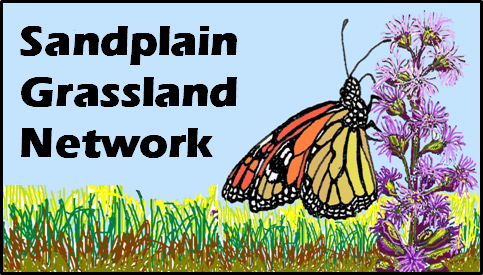By Chris Neill — Restoring native species-rich coastal sandplain grasslands onto agricultural grasslands dominated by non-native cool season grasses could expand and connect existing sandplain grasslands. A lot of what we know about how to encourage desired native sandplain grassland plants and discourage non-native (largely European) grasses comes from experiments that were installed at the Bamford Preserve on Martha’s Vineyard in 2007.

Sampling at Bamford Preserve on Martha’s Vineyard. Roberta Lombardi (left) and Ana Pulak ponder grassland plants as part of our recent resampling of an ongoing sandplain grassland management experiment on Martha’s Vineyard. Photo by Haley Miller.
In those experiments, Chris Neill, Liz Loucks, Tom Chase, Matt Pelikan, and Megan Wheeler set up 180 plots that they treated with a variety of techniques to both reduce the non-native grasses and promote the germination and establishment of native grasses and forbs. Techniques to eliminate the dominant cool-season grasses and non-native forbs included different combinations of tilling, herbicide, black plastic and even a Waipuna machine that blasted plants with hot foam. Soils in some plots were treated with elemental sulfur (to reduce pH) and sawdust (to reduce nitrogen) to test whether these amendments favored native over non-native plants. Some plots were seeded with Island-collected in different combinations over one and two years. Two papers reporting on this experiment showed that multiple tilling and seeding were most effective at encouraging native sandplain species, and that the reduced pH caused by sulfur increased little bluestem grass. Native species richness increased more than four-fold in the most effective treatments.

Not hard to get good help. A portion of our field sampling team and volunteers (from left to right), Greg Polermo, Chris Neill, Margaret Curtin, Anastasia Pulak, Haley Miller and Michael Whittemore.
One of the most important challenges in sandplain grassland management is maintaining species-rich grasslands over time. The week of July 29 a team led by Haley Miller and Anastasia Pulak of Woods Hole Research Center and Michael Whittemore of The Nature Conservancy resampled species richness and species cover in all 180 original plots. There were striking differences among plots. However, but our objective was to sample the plots “blind”—that is, not knowing exactly what the old treatments were as we were recording.
Some plots had high cover of big bluestem grass (Andropogon gerardii) and switchgrass (Panicum virgagum) as well as several species of goldenrods (Solidago sp.).
This resampling will help us formulate recommendations for sustaining over time the high-diversity grasslands that can be created from agricultural grasslands by cool-season grass removal and native plant seeding.
